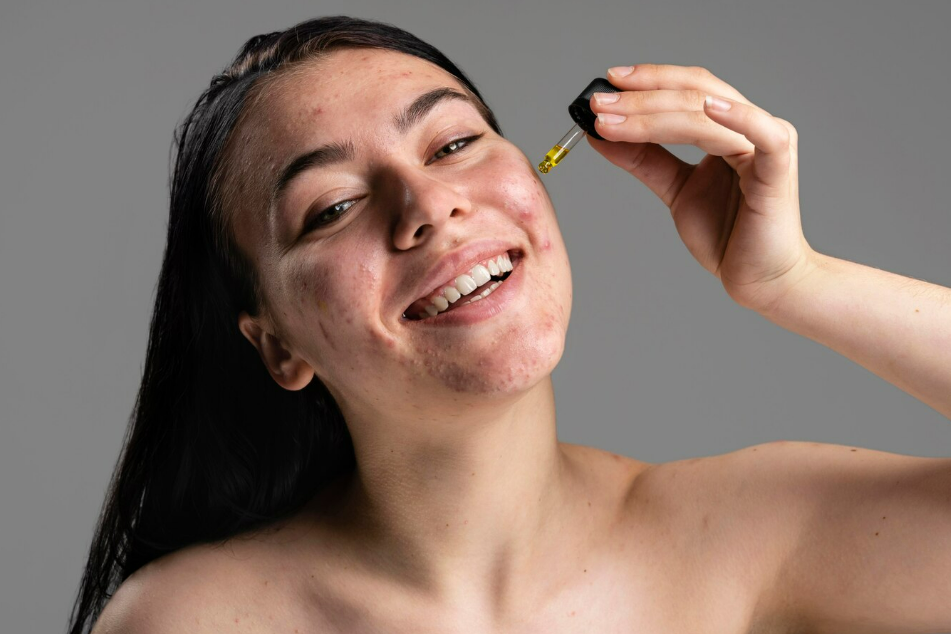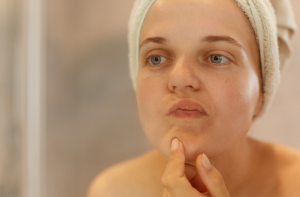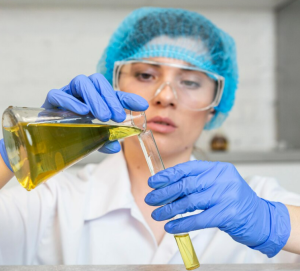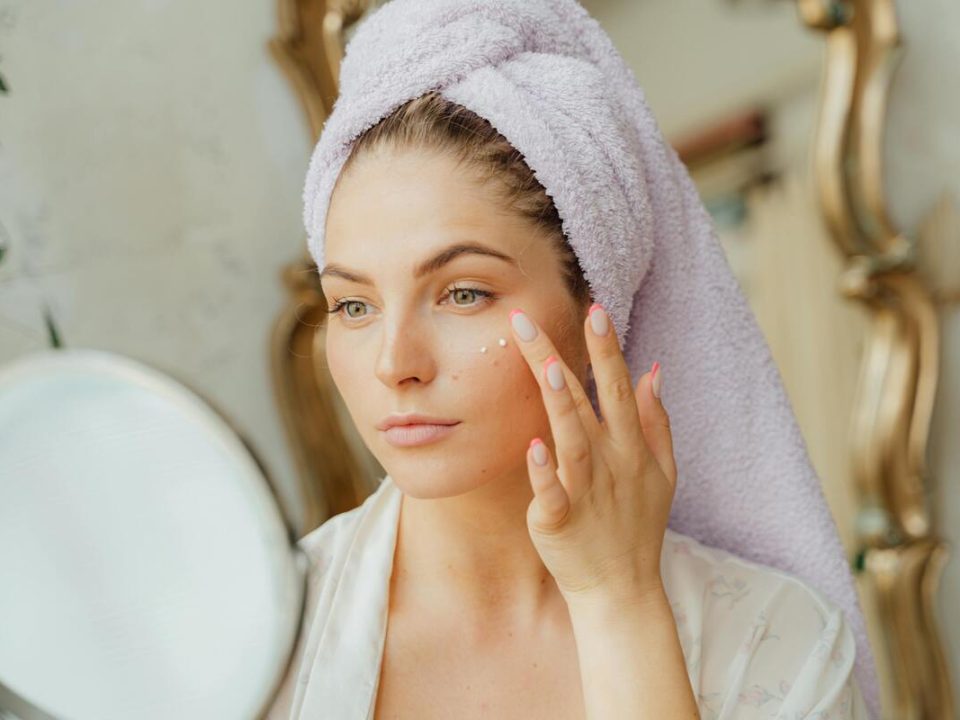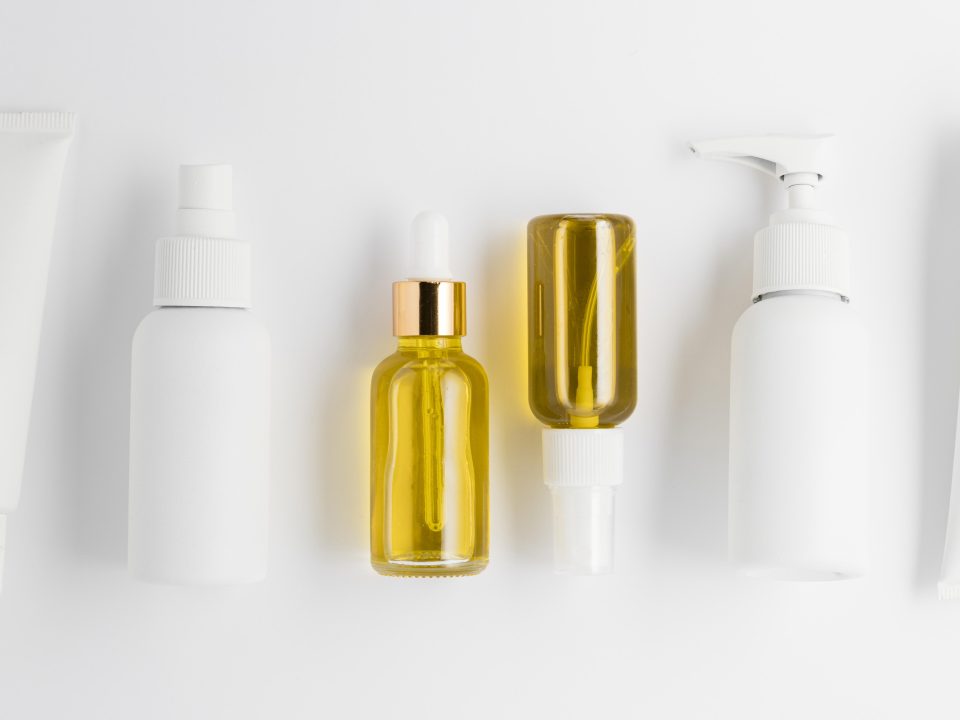
Is Salicylic Acid Ok To Use Daily?
January 26, 2024
What Can I Pair With Glycolic Acid?
January 26, 2024Yes, glycolic acid can help unclog pores by effectively exfoliating dead skin cells and debris that can trap oil and bacteria, leading to clogged pores. However, its effectiveness may vary depending on the type and severity of your clogs, skin type, and product formulations. This blog delves into the science behind glycolic acid’s pore-unclogging powers, explores its limitations, and offers tips for incorporating it into your skincare routine for optimal results.
The Enemy Within: Demystifying Clogged Pores and Their Impact
Imagine peering into the mirror and seeing a battleground. Not against external forces, but against tiny foes lurking within your pores. These adversaries, known as clogged pores, are more than just cosmetic annoyances. They’re the hidden saboteurs behind a host of skin woes: rough texture, enlarged pores, and even pesky breakouts.
For many, clogged pores are a persistent source of frustration. Their appearance can wreak havoc on self-confidence, leaving you yearning for a smooth, porcelain complexion. But fear not, brave warrior! This blog will be your guide to understanding and conquering these pore-dwelling fiends, with a special focus on a powerful weapon in your arsenal: glycolic acid.
The Hype is Real: Unveiling Glycolic Acid’s Pore-Unclogging Potential
You’ve likely heard whispers of glycolic acid, a skincare buzzword hailed as a pore-unclogging hero. But is it all just marketing hype, or does this ingredient truly hold the key to a clearer, smoother canvas? We’ll delve into the science behind glycolic acid’s claims, exploring its unique ability to exfoliate dead skin cells and debris that clog your pores. We’ll also compare it to other pore-fighting ingredients like salicylic acid, helping you understand its strengths and limitations.
Beyond the Hype: Unmasking the Truth about Glycolic Acid’s Effectiveness
But before you dive headfirst into a glycolic acid frenzy, let’s manage expectations. While this ingredient can be a potent ally, it’s not a magic wand. We’ll unpack the realities of its effectiveness, acknowledging that its power primarily lies in tackling surface clogs, not the deep-seated villains lurking within. We’ll also address potential downsides, like irritation and sun sensitivity, ensuring you’re armed with the knowledge to navigate this skincare terrain safely.
A Tailored Approach: Finding Your Glycolic Acid Match
Just like any battle, conquering clogged pores requires a customized approach. We’ll guide you through the process of choosing the right glycolic acid products based on your skin type and pore concerns. Whether you’re an oily warrior facing a sebum-fueled siege or a sensitive soul seeking a gentle exfoliator, we’ll help you find the perfect weapon.
Prepare for Battle: Building Your Skincare Arsenal
But glycolic acid alone isn’t enough. We’ll equip you with a complete skincare regimen, including cleansing, moisturizing, and sun protection – essential allies in the fight against clogged pores. We’ll also introduce alternative and complementary ingredients like niacinamide and salicylic acid, allowing you to build a personalized strategy for a flawless victory.
So, does glycolic acid really unclog pores? The answer, like most things in life, is nuanced. By understanding its strengths and limitations, and by tailoring your approach, you can harness the power of this ingredient to achieve smoother, clearer skin and emerge victorious from the battle against clogged pores.
Understanding Clogged Pores:Tiny Troublemakers Zooming in on Blackheads, Whiteheads, and Comedones
Clogged pores aren’t all created equal. Let’s meet the three main culprits
Blackheads: These little black bumps are oxidized plugs at the opening of the pore, filled with sebum (the skin’s natural oil) and dead skin cells. Exposed to air, the sebum oxidizes, turning black, but don’t let their name fool you – they aren’t dirt! While blackheads may make you want to squeeze them, resist the urge! This can worsen inflammation and lead to scarring.
Whiteheads: Unlike their black counterparts, whiteheads live under a thin layer of skin, hence their pale appearance. They’re essentially the same plugs as blackheads, but just haven’t had the chance to oxidize. While less noticeable, whiteheads can still be pesky and contribute to uneven skin texture.
Comedones: Comedones are the umbrella term for both blackheads and whiteheads. They’re essentially the earliest stage of a clogged pore, before oxidation or complete blockage occurs. By addressing comedones early, you can potentially prevent them from progressing to the more visible blackheads and whiteheads.
The Clog Creators: A Trio of Culprits
Now, let’s meet the villains behind these clogged pore dramas:
Excess Oil Production: Our sebaceous glands produce sebum, keeping our skin lubricated and protected. But sometimes, these glands go into overdrive, creating an oily slick that can contribute to pore blockage. Factors like genetics, hormones, and even stress can trigger this overproduction.
Dead Skin Cell Buildup: Our skin naturally sheds dead skin cells, making way for new ones. But sometimes, this shedding process slows down, leading to an accumulation of dead cells that can act like tiny traffic jams within the pores, trapping sebum and creating clogs.
Hormonal Fluctuations: Hormones play a key role in skin health, and their fluctuations can wreak havoc on pores. Puberty, menstrual cycles, pregnancy, and menopause can all trigger increased oil production and disrupt the normal shedding process, paving the way for clogged pores.
The Consequences of Clogged Pores: More Than Just Cosmetic Woes
Clogged pores aren’t just an aesthetic concern. They can lead to a cascade of skin issues:
Acne Breakouts: When a clogged pore gets infected with bacteria, it can turn into an inflamed pimple, leading to acne breakouts.
Enlarged Pores: Chronic clogging can stretch the pore walls, making them appear permanently larger.
Uneven Skin Texture: Dead skin cell buildup and inflammation can make the skin bumpy and uneven, impacting its overall smoothness and glow.
Exploring Glycolic Acid: The Science Behind the Buzz
Decoding the Alpha: Glycolic Acid Explained
Unveiling the AHA: Dive deeper into the world of Alpha Hydroxy Acids (AHAs) and position glycolic acid as the smallest and most water-soluble member, allowing for deeper penetration into the skin.
Sugarcane & Grapes: Nature’s Bounty: Explore the fascinating natural origins of glycolic acid, found in fruits like sugarcane, grapes, and even beets, emphasizing its gentle, naturally-derived nature.
Molecular Marvels: Explain glycolic acid’s chemical structure, highlighting the hydroxyl group responsible for its exfoliating prowess. Use relatable analogies (like a tiny key unlocking the bonds between skin cells) to simplify its action.
The Exfoliation Revolution
Dissolving the Glue: Break down the intricate process of how glycolic acid works its magic. Explain how it loosens the corneodesmosomes, the protein bridges holding dead skin cells together.
Accelerated Turnover: Illustrate the domino effect of glycolic acid’s exfoliation. With dead cells removed, the skin’s natural cell renewal process kicks in, leading to faster shedding of old layers and the emergence of fresh, radiant cells.
Beyond Surface Polish: Emphasize that glycolic acid’s exfoliation goes beyond just removing dead skin. Explain how it can also stimulate the production of enzymes that further break down desmosomes, leading to a more thorough and efficient exfoliation process.
A Multifaceted Gem: Beyond Pore-Unclogging
Brightening the Canvas: Highlight glycolic acid’s ability to tackle hyperpigmentation and uneven skin tone. Explain how it reduces melanin production and encourages cell renewal, leading to a brighter, more luminous complexion.
Collagen Boost for Youthful Glow: Explain how glycolic acid can stimulate the production of collagen, the protein that keeps skin plump and youthful. Discuss how this can lead to improved skin texture, reduced fine lines, and a firmer appearance.
Hydration Hero: Don’t forget to mention the hydrating benefits of glycolic acid! Explain how it can attract and retain moisture in the skin, leaving it feeling soft and supple, especially when used in conjunction with proper moisturization
Form Factor Frenzy: Choosing Your Glycolic Weapon
Serums for Targeted Power: Introduce serums as the most potent form of glycolic acid, offering a concentrated dose for targeted concerns. Explain their fast absorption and deeper penetration for maximum exfoliating and brightening effects.
Cleansers for Daily Defense: Discuss cleansers containing glycolic acid as a gentler option for daily use. Explain how they remove surface debris and dead skin cells while leaving the skin feeling refreshed and smooth.
Peels for Intensive Transformations: Delve into the world of glycolic acid peels, offering a more intense exfoliating experience. Explain their different strengths and application techniques, emphasizing the importance of patch testing and gradual introduction for sensitive skin.
Finding the Sweet Spot: Strength Matters
From Beginner to Pro: Discuss the range of glycolic acid concentrations available (typically from 0.5% to 15%) and emphasize the importance of starting low and gradually increasing based on individual skin tolerance.
Sensitivity & Customization: Highlight the need for caution with sensitive skin and suggest alternative options like lactic acid or mandelic acid. Encourage readers to consult a dermatologist for personalized advice on choosing the right strength and product form.

Debunking the Myth: Effectiveness of Glycolic Acid on Pores
Unveiling the Science
Exfoliation Powerhouse: Research published in the Journal of Cosmetic Dermatology revealed that glycolic acid, at a concentration of 8%, significantly reduced the number of comedones (blackheads and whiteheads) in participants after 12 weeks of use. This study highlights its effectiveness in dissolving the sticky intercellular glue that binds dead skin cells and debris, preventing them from clogging pores.
Clinical Proof in Action: A double-blind, randomized study published in the Archives of Dermatological Research observed a noticeable improvement in pore size and skin texture in individuals with mild to moderate acne after using a glycolic acid toner for 8 weeks. This suggests that regular use can help refine the appearance of pores by promoting a smoother, more even complexion.
From Lab to Life: Countless user testimonials and online reviews echo the positive effects of glycolic acid on pore clarity. Many report experiencing a reduction in blackheads and whiteheads, particularly on the nose and forehead, alongside diminished breakouts and a brighter overall appearance. These anecdotal experiences, while not scientific proof, offer valuable insights into the real-world impact of glycolic acid on individual skin.
Beyond the Hype: Understanding Limitations
Surface Savvy, Not Deep Dive: While glycolic acid excels at removing surface debris, its ability to unclog deeply impacted pores is limited. Its small molecule size allows it to penetrate the outer layers of the skin effectively, but it may not reach the sebum and bacteria trapped deep within the pores, which contribute to stubborn blackheads and acne cysts.
Sensitivity Spectrum: Glycolic acid can be a potent exfoliator, and its effectiveness comes with a potential for irritation, especially for sensitive skin types. Overuse or using high concentrations can lead to dryness, redness, and peeling. It’s crucial to start with low concentrations, gradually increase, and patch test before applying to larger areas.
Treating the Root Cause: While glycolic acid can be a helpful tool in the fight against clogged pores, it’s not a magic bullet. Addressing the underlying causes of pore congestion, such as excess oil production and hormonal imbalances, is crucial for long-term success. Combining glycolic acid with other skincare ingredients like niacinamide, which helps regulate oil production, and benzoyl peroxide, which targets acne-causing bacteria, can offer a more comprehensive approach.
Comparison Corner: Glycolic Acid vs. Salicylic Acid
Fats vs. Keratin: Glycolic acid excels at dissolving keratin, the main component of dead skin cells. This makes it ideal for removing surface debris and promoting cell turnover. In contrast, salicylic acid, a BHA, is a fat-soluble oil-cutter, making it adept at dissolving sebum and debris within the pore itself.
Gentle Giant vs. Targeted Strike: Glycolic acid tends to be gentler than salicylic acid, making it a good choice for sensitive skin. However, salicylic acid may be more effective for stubborn blackheads and oily skin due to its ability to unclog pores from within.
Finding the Fit: Ultimately, the best choice depends on your individual skin type and pore concerns. If you have mild to moderate clogged pores and sensitive skin, glycolic acid might be a good starting point. For deeper clogs and oily skin, salicylic acid may be a more effective option. Consulting a dermatologist or skincare professional can help you determine the right ingredient for your unique needs.
Against the Hype
While glycolic acid holds promise for unclogging pores, it’s crucial to understand its limitations and address the potential drawbacks before diving headfirst into an AHA routine. Here’s a deeper dive into the “against” side of the argument:
Surface Skimming
While glycolic acid excels at dissolving the surface layer of dead cells, it doesn’t reach the depths where stubborn clogs reside. Deeper pores, often filled with sebum and bacteria, require more potent ingredients like salicylic acid, which can penetrate the pore lining and dissolve the hardened gunk. Therefore, relying solely on glycolic acid might not be sufficient for tackling deeply entrenched blackheads or whiteheads.
Sensitive Skin Concerns
Not everyone embraces the exfoliating power of AHAs with open arms. Glycolic acid, especially in higher concentrations, can be a bit too enthusiastic for sensitive skin types. Irritation, redness, dryness, and even stinging can occur, especially with improper application or over-enthusiastic use. This can disrupt the skin barrier, further exacerbating clogged pores and creating a vicious cycle. For sensitive souls, starting with lower concentrations, patch testing religiously, and opting for gentler formulations are crucial for avoiding irritation and reaping the benefits safely.
Beyond the Topical Band-Aid
While topical treatments like glycolic acid can offer a helping hand, addressing the root cause of clogged pores is key to achieving long-term success. Factors like hormonal imbalances, excess oil production, and dietary choices can play a significant role in pore congestion. Addressing these underlying issues through lifestyle modifications, dietary adjustments, and hormonal regulation, if necessary, is crucial for preventing future clogs and maintaining a clear complexion. For example, managing stress, avoiding excessive sugar intake, and ensuring proper hydration can significantly contribute to a healthy skin environment, minimizing the need for heavy-duty pore-unclogging measures.

Finding Your Glycolic Acid Match: Tailoring Your Pore Rescue Plan
Navigating the world of glycolic acid (GA) can feel like deciphering a secret code. With myriad products boasting different concentrations, formats, and combinations, finding the perfect match for your unique skin and pore woes can be daunting. But fear not, pore warriors! This detailed guide will equip you with the knowledge and strategies to unlock the pore-unclogging power of GA and achieve that coveted smooth, glowy complexion.
Skin Type Matchmaker
Normal Skin: You lucky ducks with balanced skin can start with gentler 5-7% GA serums or toners. Look for hydrating formulas containing hyaluronic acid to combat potential dryness.
Dry Skin: Tread cautiously, my delicate comrades. Start with low-dose (2-4%) GA lotions or creams, and consider lactic acid, a gentler AHA. Intense moisture is key, so layer on your favorite humectants and ceramides.
Oily Skin: Rejoice, oil slicks! GA is your bestie. Embrace 7-10% serums or cleansers to keep oily shine in check. Don’t skip hydration, though – opt for lightweight, oil-free moisturizers.
Sensitive Skin: Proceed with caution, oh, gentle souls. Patch test religiously and opt for 2-3% GA in soothing formulations like micellar water or milky cleansers. Look for calming ingredients like niacinamide and centella asiatica.
Mature Skin: GA, you ageless wonder! Embrace its wrinkle-busting and collagen-boosting powers. Start with 5-7% serums or overnight masks targeted for anti-aging. Always pair with SPF, your BFF against sun damage.
Concentration Conundrum
Remember, slow and steady wins the pore race. Start with the lowest effective concentration for your skin type and gradually increase if tolerated. Listen to your skin – redness, stinging, or peeling are signs to dial it back. Patch testing on your jawline is your pre-pore party safety check.
Holistic Heroics
GA ain’t a solo act. Integrate it into your existing routine for ultimate pore power.
Cleanse: Start your pore patrol with a gentle cleanser to remove surface grime. Micellar water or oil cleansers can be great for oily skin.
Tone: Toner with low-dose GA can further refine pores and prep skin for serums.
Serums: Apply your GA hero after cleansing and toning. Layer lighter serums under heavier creams.
Moisturize: Hydration is vital even for oily skin. Choose lightweight, oil-free moisturizers to balance GA’s potential drying effects.
SPF Shield: Always, always, ALWAYS use SPF (broad spectrum, of course!). GA makes skin sun-sensitive, so protection is paramount.
Complementary Comrades
GA plays well with others! Consider these allies for targeted pore domination:
Salicylic Acid (SA): Oil-prone pals, rejoice! SA delves deeper to combat stubborn blackheads and breakouts. Pair 2-3% SA with GA in cleansers or masks, but don’t overdo it – listen to your skin and avoid over-exfoliation.
Niacinamide: Enlarged pores, be gone! Niacinamide shrinks pore size and regulates oil production. Look for 4-5% niacinamide serums or moisturizers to pair with GA for a double whammy on visible pores.
Clay Masks: For occasional deep-cleaning, clay masks can absorb excess oil and impurities. Choose gentle kaolin or bentonite clay instead of harsh drying clays.
Conclusion
Unraveling the mystery of glycolic acid and its impact on pores, we’ve reached a crossroads. Is it a pore-unclogging superhero or a mild-mannered exfoliant with limitations? The truth, as often is, lies somewhere in between.
Glycolic acid can indeed be a valuable tool in the fight against clogged pores, its exfoliating powers dissolving the bonds holding dead skin and debris like a tiny superhero with a molecular broom. This helps prevent future clogs and keeps existing ones at bay, paving the way for a smoother, clearer complexion. But it’s crucial to remember, its superpowers have limits. Deeply rooted clogs, the stubborn villains in our pore-scape, may require a different kind of hero.
Patience and consistency are the keys to unlocking the full potential of this gentle warrior. Applying glycolic acid regularly, at a concentration your skin can tolerate, is like training your skin to self-defend against pore-clogging foes. It takes time, sometimes weeks or even months, but the results can be impressive: reduced breakouts, minimized blackheads, and a refined skin texture that whispers, “Pores? Where pores?”
However, the path to pore-less victory isn’t always solo. Consulting a dermatologist or skincare professional is like calling in expert backup. They can assess your unique skin type, pore situation, and overall skincare routine, recommending the right strength and form of glycolic acid for your individual needs. This personalized approach helps maximize its effectiveness while minimizing potential irritation, ensuring your journey to clearer skin is comfortable and rewarding.
Ultimately, embracing glycolic acid isn’t about chasing some unattainable ideal of pore-less perfection. It’s about understanding its strengths and limitations, incorporating it into a holistic skincare routine with respect and patience. When used wisely, this little molecule can be a powerful ally in the battle against clogged pores, bringing you closer to a smoother, clearer complexion that radiates with newfound confidence. Remember, your skin is your own personal story, and glycolic acid, if used effectively, can be one of its brightest chapters.

